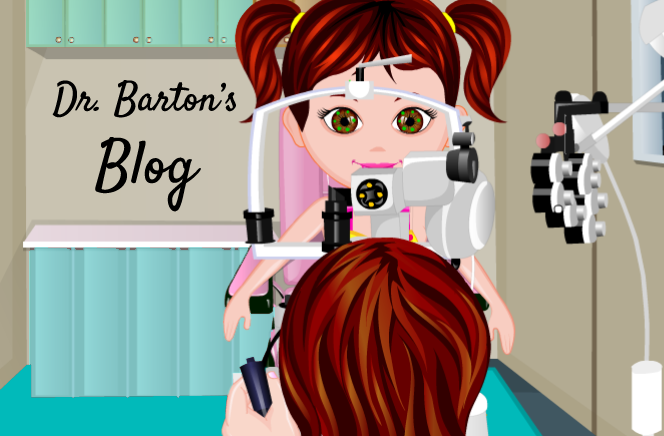
Eye Care Topics and Tips
To explore recent posts, click on the links below!


Pregnancy and Vision:
Vision can Change during Pregnancy!
As a new mom, I thought it would be a good idea to share some things about eyesight during pregnancy. Pregnancy can affect a woman’s vision, though the changes are often temporary. For example, many women complain that their contact lenses feel uncomfortable during pregnancy. The eye contours can shift due to hormones and swelling, so the lenses might not fit the same way. You may want to try a different type of contact or switch to glasses for a few months. Women with gestational diabetes should have diabetic retinopathy screenings to make sure the retina is stable. Also, it’s probably a good idea to delay getting new glasses during and immediately after pregnancy since your prescription can change until about six weeks after you quit nursing. And after Baby is born, don’t forget that the AOA recommends infants have their first checkup at age six months!
- Apply eyeliner outside the lash line away from the eye to avoid direct contact with the eye. Keep eyeliner pencils sharpened so that the rough wood casing won’t scratch the eye or eyelid.
- Replace cosmetics every three-six months, every three months for mascara if you wear contact lenses, to avoid excess contamination with skin bacteria.
- Never apply eye makeup while in a moving vehicle. You may accidentally poke the applicator into the eye during a sudden bump or stop.
- Do not use a safety pin or other sharp instrument to tease apart clumped eyelashes.
- Do not share your eye cosmetics with others. Each person has different skin bacteria. If you contaminate your cosmetics with another person’s bacteria, you may get an infection.
- Allergies can develop from the dyes or fragrances in the cosmetics which can lead to tearing, itching and redness of the eyes or eyelids. Try switching brands or consider a hypo-allergenic product.
- Always throw away your eye make-up after an eye infection.
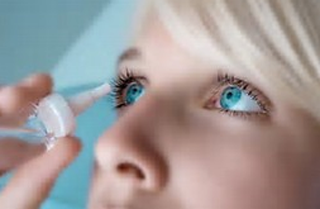
Dry Eye Disease:
Dry Eyes Are a Common Complaint!
Dry eye disease is a condition in which the eye does not have enough lubricating tear film to keep the surface moist and comfortable. It can be caused by decreased tear production, increased tear evaporation, or an imbalance in the makeup of our tears. Dry eye can be extremely uncomfortable and affect quality of life. It can also increase the chances of infection and decrease the ability to read and drive, particularly at night. The condition is most common in middle aged and older adults, particularly women. In fact, dry eye one of the leading causes of visits to the eye doctor.
There are a number of treatments available for dry eyes, including artificial tear solutions, ointments, anti-inflammatories and sometimes inserting tear duct plugs to keep moisturizing tears from draining off the eye too quickly.
During the summer, many of your children will be hitting the swimming pools, but some children may experience a temporary discomfort from the pool’s chlorine, and you may notice irritated or red, swollen eyes. Chlorine is a sanitizing agent used in swimming pools to prevent algae and to kill bacteria. While this is fantastic for our general health, chlorine can irritate our eyes. Knowing how to protect your family’s vision against the irritation of chlorine is important in helping your children enjoy their summer fun.
Goggles can keep chlorine out of your children’s eyes and help prevent irritation. This is one of those situations in which paying a little extra up front for higher quality goggles can help reduce long-term issues down the road. Cheap goggles are often ill-fitting or completely ineffective, making it well worth the few extra dollars to keep your children’s eyes healthy and their vision clear.
The irritating effect of chlorine on eyes is generally short lived once the child is out of the water for several hours. However, before you go swimming in a public or private pool, make sure you trust those responsible for its upkeep. When used correctly, chlorine can help keep swimmers safe without any adverse health risks.
 Did you know that about 80 percent of what children learn in school is through their vision? That means if your child has an uncorrected vision problem, it could severely affect his or her development. Learn some warning signs you should look for that may indicate you child has a vision problem
Did you know that about 80 percent of what children learn in school is through their vision? That means if your child has an uncorrected vision problem, it could severely affect his or her development. Learn some warning signs you should look for that may indicate you child has a vision problem
- Sitting close to the TV. While it is not true that sitting too close to the TV will ruin your eyes, this habit could be a sign of a vision problem. If your child cannot see the screen clearly or read from books without leaning in close, it could mean he or she is nearsighted.
- Holding a book too closely. If your child holds a book too close when reading, this could be a sign of a focusing or eye teaming problem.
- Rubbing eyes frequently. Children often rub their eyes when they’re tired or upset, but if your child rubs his eyes while he’s trying to concentrate on something, while he is being active, or while reading or using the computer, it could mean that he has a vision problem.
- Losing place while reading or using a finger when reading. When kids learn to read and are sounding out words, they’ll often use their finger to track which word they’re on. But eventually they should be able to stop using their finger and not lose their place. If your child continues to use a finger to read, ask him/her to try reading aloud without pointing. If this is hard, your child may have a tracking problem called an oculomotor dysfunction, meaning an inability to accurately control eye movements at close ranges.
- Sensitivity to light and/or excessive tearing. Are your child’s eyes particularly sensitive to indoor lighting, sunshine or camera flashes? Children with photophobia, or extreme sensitivity to light, can develop headaches and nausea. And light sensitivity can be a symptom of several eye conditions.
- Closing or covering one eye to read or turning the head to block vision from one eye. Frequently closing one eye could indicate a binocular vision problem, meaning an inability of the two eyes to work together comfortably as a team. Eye teaming problems can result in intermittent double vision or visual suppression where the brain is forced to block input from one eye. Closing one eye to read or work on the computer could be a sign of a specific eye teaming problem called convergence insufficiency.
- Receiving lower grades than usual. If your child is having a hard time seeing what his teacher writes on the board because of poor vision, he may not tell you about it. As a result, his grades can suffer. If your child seems to be struggling in school, take him for a complete eye exam — glasses or contacts could be the answer! Poor school performance can also be a sign of an eye teaming, tracking, or focusing problem.
- Avoiding using a computer, because it “hurts my eyes.” Digital eye strain is common among children who are frequent users of computers or other digital devices. Have your child take a break every 20 minutes to look at something that is at least 20 feet away for 20 seconds while she is using a digital device. If the eye discomfort persists, make an appointment for an eye exam.
- Squinting or tilting the head to see the class board better. Teachers should be on the lookout for students who have to squint or tilt their heads to see the board. Until an eye exam can be performed, consider moving the child closer to the board for easier viewing.
- Headaches while reading or working on the computer. Frequent headaches when reading or working on the computer can be a sign of a focusing or eye teaming problem.
If you notice any of these symptoms in your child, please schedule an appointment. School can be difficult enough without compounding the problem with an undiagnosed vision problem!
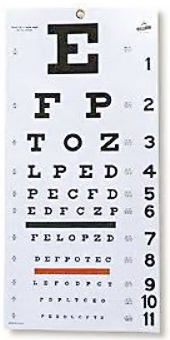 Visual acuity tests measure how well we can see at different distances and it’s usually measured by an eye chart. Most people are familiar with the Snellen chart, the one with the giant E at the top. It was developed in 1862 by Dutch eye doctor Hermann Snellen and is still used by most optometrists today, although often in an electronic form that can be calibrated to accommodate exam rooms that are less than 20 feet in length.
Visual acuity tests measure how well we can see at different distances and it’s usually measured by an eye chart. Most people are familiar with the Snellen chart, the one with the giant E at the top. It was developed in 1862 by Dutch eye doctor Hermann Snellen and is still used by most optometrists today, although often in an electronic form that can be calibrated to accommodate exam rooms that are less than 20 feet in length.
The Snellen chart consists of 11 rows of capital letters, with each row being smaller print than the last. During testing, the patient is asked to stand a specific distance from the chart and read the letters to the doctor. Each eye is separately tested as our eyes are not identical and one is often weaker than the other. The smallest line that they can see clearly represents the acuity of their vision, with the big E at the top being 20/200 (which as you can imagine, is not very good) and the 8th line down 20/20 vision, which is considered normal. The remaining 3 lines represent better-than-normal vision, with the smallest line being 20/10. If you can read this last line, you have fantastic vision! For those too young to read or who are illiterate, the tumbling E chart is used. It is similar to the Snellen chart, but instead of having different letters, each row is made up of the letter E facing different directions. So rather than read the letters aloud, the patient has to indicate which direction the ‘fingers’ of the Es are facing.
Visual acuity is measured in a fraction; 20/20 is considered normal, meaning you have the clarity and sharpness of vision to recognize the appropriate row of letters at a distance of 20 feet. If you have 20/100 vision it means that at 20 feet you can only see what a normal person can see at 100 feet, so your eyesight would be very poor. 20/10 vision, on the other hand,would mean you have exceptionally good vision, being able to read at 20 feet what a normal person could only read at 10 feet.
20/10 is usually the maximum acuity the human eye can reach without using aids like binoculars. In comparison, a hawk, which is known for its sharp vision, is believed to have an acuity of 20/2 which is far better than our unaided eyesight. On the other side of the scale, a newborn baby has an estimated visual acuity of 20/400, developing to 20/20 by the age of 2 years old. To get a driver’s license you need 20/40 vision or better, with or without glasses. If your visual acuity with the best glasses or contact lenses the doctor and prescribe for you is still 20/200 or worse, than you are considered legally blind.
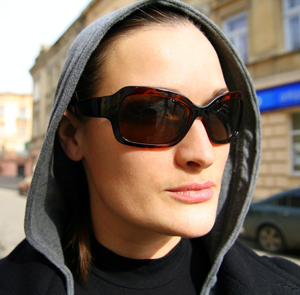 There is a lot more that goes into finding the right pair of sunglasses than just fashion. Sunglasses have the very important job of protecting your eyes from harmful ultraviolet rays from the sun that are linked to eye diseases such as cataracts and macular degeneration. Here are some things to consider when picking out your next pair of sunglasses:
There is a lot more that goes into finding the right pair of sunglasses than just fashion. Sunglasses have the very important job of protecting your eyes from harmful ultraviolet rays from the sun that are linked to eye diseases such as cataracts and macular degeneration. Here are some things to consider when picking out your next pair of sunglasses:
100% UV protection: The number one most important feature of your sunglasses must be proper UV protection. Look for a pair that blocks 99-100% of UVB and UVA rays. Lenses labeled as “UV 400,” block all light rays with wavelengths up to 400 nanometers, which includes all UVA and UVB rays.
Frame size: Pay attention to the size of the frame – the bigger, the better. Wrap-around styles are the best frames for keeping UV rays from entering through the sides or top of the glasses.
Also, for your eye health protection, you need to wear sunglasses even on overcast days. Dangerous UV rays can penetrate clouds and reflect off water or snow. So even when the sun isn’t shining, a good pair of sunglasses should be worn every day to keep your eyes safe and to help you see your best.
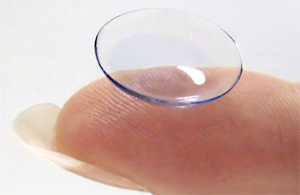 If you wear contact lenses, it’s important to follow these steps when removing your lenses:
If you wear contact lenses, it’s important to follow these steps when removing your lenses:
- Wash your hands thoroughly with soap and water and dry them on a clean, lint free cloth.
- Remove the lens from your eye and clean the lens immediately with a solution recommended by Dr. Barton. Rinse the lens thoroughly and gently scrub it clean from edge to edge. Do not wait until morning because debris can get stuck on the lens making the delayed cleaning harder and less effective.
- Place the contact lens in their case that’s filled with fresh solution and close the lid. Never reuse solution since recycled solution is contaminated.
Do NOT cleaning your contacts with saliva or water. Saliva is full of bacteria that belong in your mouth and not in your eyes. If you have a cut in your eye, the bacteria could get trapped under your lens and cause an infection. Even though tap water seems harmless, tap water can cause serious damage to your eyes since it is not sterile and can cause infections. Always carry a small container of lens solution or artificial tears. Don’t wear contacts if your vision is blurry or your eyes hurt, even a little. If your eyes are bothering you, first try applying lubricating drops made for contact lens wearers. If that doesn’t help, take the lenses out and check them to make sure they are not damaged or dirty. If it does not look good to you, do not use it.
Always follow to your contacts wearing schedule. Contacts worn past their approved replacement date can lose their structure, and mucus and bacteria can build up, increasing the risk of eye irritation and infection.
Improper use and poor hygiene of contact lens puts your eyes and vision at risk. See me immediately is you have red eyes, blurry vision, irritation, or signs of an infection.
When most parents think about vision, they think about their children’s eyesight, i.e., visual acuity as measured by the eye chart. When children have 20/20 vision, it means they can see what an average person sees on the eye chart at a distance of 20 feet. If children fail the eye chart test, they can get glasses to compensate for their eyes’ physical irregularities that cause blurry vision. But good vision is so much more than just clear eyesight at distance.
 Near visual skills at close ranges are especially important to school-aged children, who spend their days viewing images at a distance of 20 inches, not 20 feet. Looking up close is much more demanding on our visual system than looking far away and involves very precise visual skills in the way we take in, or process, visual information.
Near visual skills at close ranges are especially important to school-aged children, who spend their days viewing images at a distance of 20 inches, not 20 feet. Looking up close is much more demanding on our visual system than looking far away and involves very precise visual skills in the way we take in, or process, visual information.
At close distances, children need to the ability to coordinate or “team” their eyes in order to maintain single vision. They need to be able to track a line of print without losing their place. They need to the ability to quickly adjust focus when looking from near to far, as when they’re copying from the board. Children also need to be able to interpret and make sense of what they see, commonly referred to as visual perception. Glasses cannot correct these types of problems because, unlike eyesight, visual processing problems are not caused by physical irregularities in the shape of their eyeballs. Rather, these visual processing problems are hard-wiring deficits in the brain caused by poor visual development in the first few years of life.
Visual processing skills develop much the same way our motor skills are acquired, i.e., with practice and use. Just as infants must learn to roll over, crawl, and walk, their eyes must also learn to track, team, focus, and interpret what they see. We’re born with all the eye structures we need for vision, but we spend the first 4-6 months of life getting “hard wired” in the brain’s visual cortex to use our visual equipment correctly, and then we continue fine-tuning these skills throughout early childhood.
So what happens if something goes wrong, and these important visual skills don’t develop normally? Vision becomes less efficient and takes more effort. Uncomfortable vision is especially noticeable at school where reading becomes an exercise in frustration and fatigue. Depending on the clinical criteria researchers adopt to identify the prevalence of vision deficits, studies show around 20-25 percent of the population have some degree of poor visual processing skills. If we isolate poor readers, this number rises significantly because nowhere is vision more demanding than at close ranges with small print. Each year as the reading demands increase and print gets smaller, children with poor visual processing skills find it harder to maintain clear, comfortable, single vision. Grades start to drop, comprehension falls, and eyestrain makes it difficult to remain on task, forcing these children to take frequent breaks. They are so often off task that they may look like they have ADD/ADHD, or their grades are so poor that teachers start questioning if they have a learning disability. Unfortunately, few teachers or parents even suspect that the underlying cause may be vision.
All school-aged children should have a comprehensive eye exam to evaluate their visual processing skills. This is a specialized area of pediatric vision care about which I’m passionate and have completed extensive post-graduate training. You can rest assured that when I see your children for their eye exams, I will not only evaluate their sharpness of vision and general eye health, but I will also evaluate their visual processing skills that are necessary for the demanding close work required for good school performance and sustained attention.
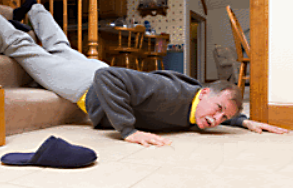 According to a recent study, 65% of seniors who wear glasses and break a hip as a result of a fall were not wearing their glasses at the time of the fall. Whether it is a pair of corrective glasses or surgery to remove a cataract, treating vision problems in the elderly can have a huge impact on preventing injuries related to falling.
According to a recent study, 65% of seniors who wear glasses and break a hip as a result of a fall were not wearing their glasses at the time of the fall. Whether it is a pair of corrective glasses or surgery to remove a cataract, treating vision problems in the elderly can have a huge impact on preventing injuries related to falling.
Poor vision doesn’t only increase the risk of falling, but it also has an impact on the quality of daily life. If left untreated, a visual disorder can affect both social and physical activities. A person who is unable to see clearly will have difficulty participating in stimulating activities such as interacting at social gatherings, reading, playing cards or board games, and day-to-day physical exercise such as walking.
Vision difficulties for seniors can often be treated once detected, but a thorough eye exam is necessary to determine the cause. With most vision diseases, earlier detection leads to increased chances of vision improvement. For those older friends and family members, help raise their awareness about the relationship between vision difficulties and health problems. An annual eye exam is the first step to help increase their quality of life and help lower the risk of serious injury associated with avoidable falls.
Twitching eyelids can be annoying, but the problem is actually quite common. Here are some things you should know about this eye condition:
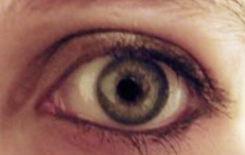 Eye twitches are generally caused by a repetitive, involuntary spasm in your eyelid muscles and are usually short in duration.
Eye twitches are generally caused by a repetitive, involuntary spasm in your eyelid muscles and are usually short in duration.- Stress, tiredness, eyestrain, caffeine, alcohol, smoking, dry eyes, allergies, or nutritional deficits are factors that can trigger or worsen eye twitches. The body produces a steroid called endogenous cortisol when stressed, which may cause biological warning signs to the body to de-stress. If reducing these factors don’t relieve the twitching, you might consider coming in for an exam. Sometimes the solution is reducing eyestrain by updating your glasses prescription.
- Eyelid spasms are generally harmless and are only considered a medical emergency when the twitch is accompanied by red or swollen eyes, unusual discharge, a drooping eyelid or twitching in other parts of the face. These may be symptoms of a more serious neurological disorder
 Seafood with Omega -3’s: Omega-3 fatty acids, found in cold-water fish such as tuna, salmon, mackerel and sardines, may help lower the risk of dry eyes and certain eye diseases such as macular degeneration and cataracts. If you don’t like seafood, consider taking fish oil supplements or other supplements that contain omega 3’s, such as black current seed or flaxseed oils.
Seafood with Omega -3’s: Omega-3 fatty acids, found in cold-water fish such as tuna, salmon, mackerel and sardines, may help lower the risk of dry eyes and certain eye diseases such as macular degeneration and cataracts. If you don’t like seafood, consider taking fish oil supplements or other supplements that contain omega 3’s, such as black current seed or flaxseed oils.
Green and Orange Veggies: Leafy green vegetables such as spinach, kale, broccoli, zucchini, peas, avocado and Brussels sprouts contain Vitamin A and important nutrients for eye health. Orange veggies like carrots and sweet potatoes are also excellent for your eyes. The Age-Related Eye Disease Study conducted by the National Eye Institute demonstrated that these important pigments help prevent the progression of some eye diseases.
Limit fats and sugars: Keeping your diet low in fat and sugar and high in nutrients can help reduce your risk of developing age-related macular degeneration and diabetes, two of the leading causes of blindness.
Drink green tea. Green tea is another great source of antioxidants which keep eyes healthy and defends them from cataracts and AMD development.
 Electronic devices with screens and monitors are part of our everyday lives. We encounter them everywhere, from our personal smartphones to desktop computers to tablets, and we’re spending more and more time looking at electronic devices. Blue light and glare from screens and the close viewing distance can lead to eyestrain, often called Computer Vision Syndrome. Symptoms include eye fatigue, burning or tired eyes, the inability to focus, headaches, blurred vision, double vision, or head and neck pain.
Electronic devices with screens and monitors are part of our everyday lives. We encounter them everywhere, from our personal smartphones to desktop computers to tablets, and we’re spending more and more time looking at electronic devices. Blue light and glare from screens and the close viewing distance can lead to eyestrain, often called Computer Vision Syndrome. Symptoms include eye fatigue, burning or tired eyes, the inability to focus, headaches, blurred vision, double vision, or head and neck pain.
Viewing Distance. The distance that we view screens from can impact our how comfortable our vision is. We tend to hold cell phones at much closer distances than we would printed pages. Hold handheld devices at least 16 inches away from our eyes. Our computer monitor should be positioned least an arm’s length away.
We Need to Blink. Another result of extended use of electronic devices is that our blink rate tends to drop when we stare at text on a screen. Not blinking often enough can lead to dry, irritated eyes.
Take Vision Breaks. Apply the 20-20-20 rule: every 20 minutes look at an object 20 feet away for 20 seconds. Distance viewing is much easier on our eyes and looking away can relieve some of the stress and strain we’re putting on our visual system.
Glaucoma is a serious, vision threatening disease. You can save your eyesight by knowing the facts. Anyone can get glaucoma, young and old alike. Glaucoma has no symptoms in its early stages, and is the leading cause of blindness in this country. Therefore, early detection and treatment through an annual eye exam is important to save your eyesight. However, there are risk factors that make one more prone to developing the disease:
- Over age 40: While glaucoma is known to occur in younger patients, even infants, the likelihood increases with age, particularly in those over the age of 40.
- Family history: There is a genetic factor to the disease, making it more likely that it will occur when there is a family history.
- Elevated Intraocular Pressure (IOP): Individuals that have an abnormally high internal eye pressure have a dramatically increased risk of developing glaucoma.
- Race: Evidence clearly shows race is a factor and individuals from Latino, African and Asian backgrounds are at increased risk of developing glaucoma. African Americans in particular are at a higher risk, tending to develop glaucoma at a younger age and have a higher incidence of blindness from the disease.
- Diabetes: Diabetes, particularly when it is uncontrolled, increases the risk of a number of vision threatening diseases including diabetic retinopathy and glaucoma.
- Eye injury, disease or trauma: If you have suffered a serious eye injury in the past, your risk of glaucoma is increased. Similarly other eye conditions such as tumors, retinal detachment, lens dislocation or certain types of eye surgery can be factors.
- Extremely high or low blood pressure: Since glaucoma has to do with the pressure inside the eye, abnormal blood pressure can contribute to an increased risk in the disease.
- Long-term steroid use: Prolonged use of certain corticosteroid medications, such as prednisone, particularly in eye drop form, may also increase your chances of getting glaucoma.
- Myopia (nearsightedness) or hyperopia (farsightedness): Poor vision may increase your risk of developing glaucoma.
Comprehensive eye exams are the key to preventing vision threatening diseases and blindness.


